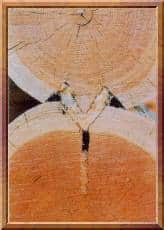
Menu

(Article written in 1986 by Lloyd Beckedorf, originally for the Log Home Guide Magazine – edited for use on our web site.)
To properly explain the “Shrink-Fit Saddle Notch” and the “Double-Scribe Lateral Groove” systems, an understanding of the properties of wood and how the properties affect a log house is necessary first.
The changing moisture content in logs directly affects the performance of a log home. Without any shrinkage or re-swelling of wood, any union of two pieces of wood would virtually remain unchanged and air leakage would be of little concern.
The initial solution would appear to be, to ensure that no moisture is taken on or lost by the wood after the joinery has been completed. To totally seal up or kiln dry large pieces of wood has often been attempted, but to my knowledge never been achieved without the wood fiber in logs or timbers receiving destructive side effects. Major checks (cracking) are the most common side effects of a forced quick drying. Sealing wood to prevent it from breathing usually results in decay. One of the reasons why log homes are so healthy to live in is that they do, to some degree, naturally breathe on their own. This however totally different than fast dried and uncontrolled checking which, will when intersecting joinery, result in air and weather leaks requiring synthetic chinking or caulking for sealing.
So then let us look at what happens to wood as it shrinks. Shrinkage is the main factor in wood which affects the performance of a log house after it is built. With the exception of wood dried to a moisture content of below approximately 12% then shipped to an environment where it basically rains continuously, wood will continue to shrink after it is built into a home. It may be noted here that even under these rare circumstances, settling will occur due to compression of wood bearing weight from the logs, roof and snow-load above. Under normal circumstances, even in a very dry climate it is almost impossible to air dry wood outdoors to a moisture content of less than 15%. I would also like to add I know of manufacturers claiming to have no requirements necessary for settling in their buildings for whatever reasons. If those buildings did not and were not allowed to settle, they were without fail hung-up on doors, windows, interior partitions, fireplaces, or whatever, and the lack of settling allowance was accounted for by the large gaps between log work that had the weight transferred onto these “hang-ups”. All log buildings settle, it is a simple natural fact and settling only creates problems when it is not allowed for! From my experience a minimum safe settling allowance for “kiln dried” or thoroughly air dried wood is 3%, or for every foot of wall height, 3/8th of an inch settling space. With wood dried less, the safe settling allowance is 6%, or 3/4 of an inch per foot of wall height. To allow less can only be considered a gamble or lack of knowledge!
After the realization that settling is going to occur and allowances are made for this, to allow for 3% or 6% is really no difference in the workload. Then the question is, seasoned wood or not? It has been my experience, that to have any profound effect on reducing the shrinkage of wood in the 12″-18″ average diameter size generally being used in the hand-hewn log home industry, it would require 3 to 10 years of seasoning under a shed roof or indoors. Because logs, as they impact log construction, really do not shrink to a significant enough degree until the moisture content drops below 20%, seasoning logs exposed to the weather requires more than 3 to 10 years depending on the dryness of the climate. Now, if your wood is well seasoned, minimally checked or cracked which creates almost countless air leaks and the coloring of this seasoned wood is to your liking, then you have first quality logs which will shrink somewhat less, but including compression, those logs still will most likely settle at least 3%.
Understanding this, it becomes quickly apparent why the bulk of the fully scribed log home industry does not choose to use seasoned (or kiln dried) timber. But in unseasoned timber there is the difference, like night and day, in the quality of wood. It can generally be assumed that wood cut in the coldest part of winter is superior to wood cut at any other time of the year because the majority of sap and moisture is being stored in the roots. The next most desirable time to harvest is August and towards the end of the growing season, when the sap is still in the crown and the driest part of summer has reduced the overall moisture in the trunk of the tree. Logs felled during these times are significantly less prone to checking or cracking and less susceptible to insects or rot.
It is now important to understand how wood shrinks. If wood, in a cross-section view, would shrink in a radial direction at the same rate, or in other words, shrink in relation towards the center at the same rate as it does in circumference (or tangentially) at the outer surface, logs would not check at all in the drying process. However, such is not the case. The inner “heart” wood contains less moisture than other outer “sap” wood. This, combined with the situation that generally only the sap wood is exposed to drying, means that the sap wood shrinks at a faster rate and more so than the heart wood. If one looks at the sap wood as approximately 1-1/2″ thick skin that is trying to shrink around a core which is not willing to shrink at the same rate, then something has to give. What occurs are splits in the outer surface or checks. It is the way wood relieves its own internal forces. So, not only is the outer wood shrinking in circumference, but also in diameter.
These situations have confronted log builders since construction began thousands of years ago. Many avenues have been tried and proven, most dictated by the access to tools, timber and the time required to build.
The systems I choose to use work with the properties of wood to the benefit of a home, not against the natural forces in wood.
A system to reduce and control checking by allowing wood to relieve the forces created by drying in a specified location on the log could be many hundreds of years old. Methods used included making long kerfs down the lengths of the log on TOP, or driving wooden wedges also on the TOP, or combining both to promote checking to relieve the internal forces in logs. This was done in a location where the next round of logs above would hide this checking. These situations are generally quite effective, but with modern tools, even more effective systems are possible.
A method I use for the fit down the length of the logs is called the “Double-Scribe Lateral Groove” which allows the upper log to effectively cap with an overlap the log below. However, the bulk of the wood for the groove is removed from the log below.
This has several very important advantages:
The challenge is: this system requires more skill then the conventional procedures!
We now have a fit that works with the movement in logs to keep a wall as weather-tight as wood on wood can be, and because the fit stays tighter, it also looks much better.
|
|
(These logs on the left are fully settled, about 5 years old and on the right under construction)
So now we need a notch that works as well as our “Double-Scribe Lateral Groove”. As any experienced builder knows, to make a notch fit initially is relatively easy. To be able to guarantee a tight fit later requires a complete understanding of wood and a notch that adjusts itself, not only with compression, but actually takes advantage of shrinkage. Such a notch must look good after shrinkage and also block any air movement and should also be interlocking to provide the most stable of corners.
With this in mind and after numerous improvements, I have developed what I call a line of “Shrink-Fit” notches. I have been using variations of Shrink-Fit notches since 1981 with more than exceptional results. Even further improvements have developed from the close scrutiny of an unique situation in log homes, that only 1/2 of the log is basically drying out at one time.
In most every climate in the winter, the inside is drying out at a faster rate than the outside, and the reverse holds true in summer.
The “Shrink-Fit Saddle Notch” differs from the standard upside-down “V” shaped saddle notch (or Scandinavian notch) in that the quarter of the notch facing into the building has a pronounced wedge. As the next log capping this wedge shrinks, it tightens on this wedge.
Based on experience, the wedge is only necessary and performs best on the quarter of the saddle that points into the heated area. The heel of this wedge acts as an air stop and when cut properly is an extremely secure interlock, making it one of the most stable of corners.
The results of our patented system have for decades proven so superior that we guarantee against air or weather leaks, something we know no other log home manufacturer’s system, hand-built or machined-kit, could come close with equivalent performance or warranties. Equally if not more important is that we have been guaranteeing against leakage with this system since 1985 and we have not had our first air or weather leak. In fact, we are so confident, we are certain we will never have our first leak, something we know you will only find in a Moose Mountain Log Home.
#46 Griffin Industrial Point
Cochrane, AB
T4C 0A3